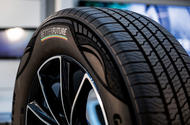The tyre has a lower rolling resistance which reduces the car’s carbon footprint
Goodyear’s demonstration tyre is 90% sustainable, using ingredients from soybean oil to plastic bottles
Some aspects of making cars more sustainable are taking much longer than others, but one that appears to be making quicker progress is the tyre.
Goodyear has announced a demonstration tyre made from 90% sustainable materials that meets all the necessary regulations and has passed its own internal tests for performance and safety.
The tyre isn’t only substantially greener than conventional counterparts but has a lower rolling resistance too, reducing the carbon footprint during use of any car fitted with them.
In 2021 and 2022, Goodyear, Michelin, Continental and Falken all reported progress in replacing petroleum-based ingredients of tyre compounds with renewable materials. One example is the use by Goodyear and Continental of natural latex derived from the roots of dandelions, while Michelin has been working on its Bio Butterfly project to develop a bio version of butadiene rubber from fermented biomass.
At the start of 2022, Goodyear announced success in constructing a tyre made from 70% sustainable materials, and that tyre will go into production this year. More work needs to be done by the company and its suppliers to figure out how enough materials can be sourced to make its 90% green tyre a commercial reality.
Tyres are ferociously complex, despite their boring appearance. Goodyear’s 90% demonstration tyre is made from 17 ingredients across 12 different components within the tyre. Rather than being made from burning petroleum-based products, carbon black, used to reinforce the compound and increase tyre life, is derived from four different sustainable sources in the new tyre: methane, carbon dioxide, plant-based oil and pyrolysis oil from recycled tyres.
Soybean oil is used to ensure the compound remains pliable across different temperature ranges. The oil is a leftover byproduct of soy protein food and animal-feed manufacturing.
The silica used in tyres to improve grip and reduce rolling resistance (and fuel consumption) has been produced from rice-husk waste (RHA silica), which again is a byproduct, this time from rice processing, and usually ends up in landfill. Goodyear says it’s on track to produce the first tyre made from 100% sustainable materials by 2030.
Polyester is still used in the new tyre, but it’s recycled from plastic bottles. The bottles are reduced to base chemicals and then reformed into the high-grade polymer used for making the tyre cords that form the skeleton of the tyre carcass.
Other stuff includes resins, used to help generate traction and derived from renewable pine resin in place of petroleum-based resin. Also, the steel cords used in the structure of a radial tyre are made from steel containing a high proportion of recycled steel.
Electric arc furnaces used to smelt the steel produce fewer greenhouse gas emissions than the traditional blast furnace. ISCC-certified (International Sustainability and Carbon Certification) polymers from renewable bio sources are also used in the tyre.
A revolutionary inverter from McLaren Applied

McLaren Applied says its compact IPG5 800V silicon-carbide inverter enables EV-developer customers to run different switching frequencies so that it can be used with a variety of EV traction motors. The aim is to remove mechanical constraints from EV-powertrain design, making them software-defined. The company has also partnered with Elaphe Propulsion Technologies to combine its inverter with the Slovenian company’s in-wheel motors.
Source: Autocar
